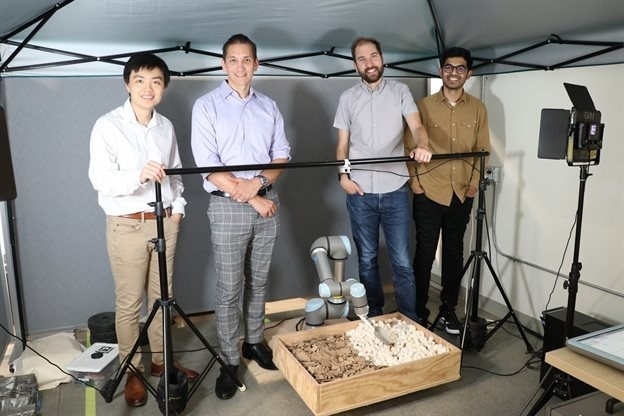At the University of Illinois Urbana-Champaign, scientists in the Departments of Aerospace Engineering and Computer Science have devised a novel learning-based method so robots on extraterrestrial bodies can make decisions regarding where and how to lift out terrain samples.

Left to right: Yifan Zhu, Kris Hauser, Melkior Ornik, and Pranay Thangeda. Image Credit: University of Illinois Urbana-Champaign
Rather than simulating how to scoop every possible type of rock or granular material, we created a new way for autonomous landers to learn how to learn to scoop quickly on a new material it encounters.
Pranay Thangeda, Ph.D. Student, Department of Aerospace Engineering, University of Illinois Urbana-Champaign
Thangeda stated, “It also learns how to adapt to changing landscapes and their properties, such as the topology and the composition of the materials.”
With the help of this technique, Thangeda stated that a robot could learn how to scoop a new material with very few attempts.
Thangeda stated, “If it makes several bad attempts, it learns it shouldn’t scoop in that area and it will try somewhere else.”
One of the difficulties of this study is the lack of understanding regarding ocean worlds like Europa.
Before we sent the recent rovers to Mars, orbiters gave us pretty good information about the terrain features. But the best image we have of Europa has a resolution of 256 to 340 meters per pixel, which is not clear enough to ascertain features.
Pranay Thangeda, Ph.D. Student, Department of Aerospace Engineering, University of Illinois Urbana-Champaign
Thangeda’s adviser Melkior Ornik said, “All we know is that Europa’s surface is ice, but it could be big blocks of ice or much finer like snow. We also don’t know what’s underneath the ice.”
For a few trials, the research group concealed a material under a layer of something else. The robot observes the top material and thinks it may be good to scoop.
“When it actually scoops and hits the bottom layer, it learns it is unscoopable and moves to a different area,” stated Thangeda.
NASA wishes to send battery-powered rovers instead of nuclear to Europa because, among other mission-specific considerations, it is vital to reduce the risk of contaminating ocean worlds with possibly risky materials.
Although nuclear power supplies have a lifespan of months, batteries have about a 20-day lifespan. We can't afford to waste a few hours a day to send messages back and forth. This provides another reason why the robot’s autonomy to make decisions on its own is vital.
Pranay Thangeda, Ph.D. Student, Department of Aerospace Engineering, University of Illinois Urbana-Champaign
Also, this learning technique is special since it enables the robot to utilize vision and minimal online experience to obtain high-quality scooping actions on strange terrains. This considerably surpasses non-adaptive techniques and other advanced meta-learning techniques.
A robot in the Department of Computer Science at Illinois was utilized by the research group. It is modeled following the arm of a lander with sensors to gather scooping data on a range of materials, from 1-mm grains of sand to 8-cm rocks, and also different volume materials like packing peanuts and shredded cardboard.
The consecutive database in the simulation comprises around 100 points of knowledge for each of 67 various terrains, or 6,700 total points.
Thangeda stated, “To our knowledge, we are the first to open source a large-scale dataset on granular media. We also provided code to easily access the dataset so others can start using it in their applications.”
The model that was made by the team will be dispensed at NASA’s Jet Propulsion Laboratory’s Ocean World Lander Autonomy Testbed.
Ornik stated, “We’re interested in developing autonomous robotic capabilities on extraterrestrial surfaces, and in particular challenging extraterrestrial surfaced. This unique method will help inform NASA’s continuing interest in exploring ocean worlds.”
Ornik added, “The value of this work is in adaptability and transferability of knowledge or methods from Earth to an extraterrestrial body, because it is clear that we will not have a lot of information before the lander gets there.”
Ornik continued, “And because of the short battery lifespan, we won’t have a long time for the learning process. The lander might last for just a few days, then die, so learning and making decisions autonomously is extremely beneficial.”